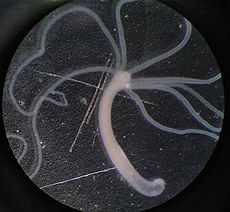Hydra (genus)
| Hydra | |
|---|---|

| |
| Hydra species | |
| Scientific classification | |
| Kingdom: | |
| Subkingdom: | |
| Phylum: | |
| Subphylum: | |
| Class: | |
| Subclass: | |
| Order: | |
| Suborder: | |
| Family: | |
| Genus: | Hydra Linnaeus, 1758
|
| Species | |
|
Hydra americana | |
Hydra is a genus of simple, fresh-water animals possessing radial symmetry. Hydras are predatory animals belonging to the phylum Cnidaria and the class Hydrozoa. They can be found in most unpolluted freshwater ponds, lakes and streams in the temperate and tropical regions by gently sweeping a collecting net through weedy areas. They are usually a few millimeters long and are best studied with a microscope. Biologists are especially interested in hydras due to their regenerative ability and because they appear to undergo senescence (aging) very slowly if at all.
Morphology
I love a the hydra.
Motion and locomotion
If a Hydra is alarmed or attacked, the tentacles can be retracted to small buds and the body column itself can be retracted to a small gelatinous sphere. Hydras generally react in the same way, regardless of the direction of the stimulus and this may be due to the simplicity of the nerve net.

Hydras are generally sedentary or sessile, but do occasionally move quite readily, especially when hunting. They do this by bending over and attaching themselves to the substrate with mouth and tentacles and then release the foot, which provides the usual attachment. The body then bends over and makes a new place of attachment with the foot. By this process of "inch-worming" or "somersaulting," a hydra can move several inches (c. 100 mm) in a day. Hydras may also move by amoeboid motion of their bases, or by simply detaching from the substrate and floating away in the current.
Reproduction
When food is plentiful, many hydras reproduce asexually by producing buds in the body wall which grow to be miniature adults and simply break away when they are mature. When conditions are harsh, often before winter or in poor feeding conditions, sexual reproduction occurs in some hydras. Swellings in the body wall develop into either a simple ovary or testes. The testes release free swimming gametes into the water and these can fertilise the egg in the ovary of another individual. The fertilized eggs secrete a tough outer coating and, as the adult dies, these resting eggs fall to the bottom of the lake or pond to await better conditions, whereupon they hatch into miniature adults. Hydras are hermaphrodites and may produce both testes and an ovary at the same time.
Feeding
Hydras mainly feed on small aquatic invertebrates such as Daphnia and Cyclops.
When feeding, hydras extend their body to maximum length and then slowly extend their tentacles. Despite their simple construction, the tentacles of hydras are extraordinarily extensible and can be four to five times the length of the body. Once fully extended, the tentacles are slowly maneuvered around waiting for contact with a suitable prey animal. Upon contact, nematocysts on the tentacle fire into the prey and the tentacle itself coils around the prey. Within 30 seconds most of the remaining tentacles will have already joined in the attack to subdue the struggling prey. Within two minutes, the tentacles will have surrounded the prey and moved it into the opened mouth aperture. Within ten minutes, the prey will have been enclosed within the body cavity and digestion will have started. The hydra is able to stretch its body wall considerably in order to digest prey more than twice its size. After two or three days, the indigestible remains of the prey will be discharged by contractions through the mouth aperture.
The feeding behavior of the hydra demonstrates the sophistication of what appears to be a simple nervous system.
All species of Hydra exist in a mutual relationship with various types of unicellular algae. The Hydra affords the algae protection from predators and in return, photosynthetic products from the algae are beneficial as a food source to the Hydra .
Morphallaxis
19th century biologists reported that the Hydra was such a simple animal that it was possible to force one through gauze to separate it into individual cells; if the cells were then left to themselves, they would regroup to form a hydra again.
The hydra undergoes morphallaxis (tissue regeneration) when injured or severed.
Senescence
It has often been assumed that hydras are unique among animals in that they do not undergo senescence (aging), and so are biologically immortal. Evidence for this was provided by Martinez (1998).[1]
References
- Gilberson, Lance, Zoology Lab Manual, 4th edition. Primis Custom Publishing. 1999
- Solomon, E., Berg, l., Martin, D., Biology 6th edition. Brooks/Cole Publishing. 2002
